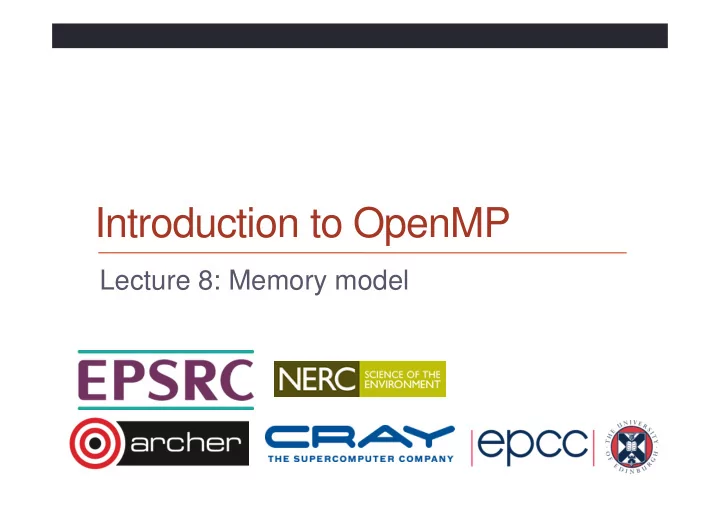

Introduction to OpenMP Lecture 8: Memory model
Why do we need a memory model? • On modern computers code is rarely executed in the same order as it was specified in the source code. • Compilers, processors and memory systems reorder code to achieve maximum performance. • Individual threads, when considered in isolation, exhibit as-if-serial semantics. • Programmer’s assumptions based on the memory model hold even in the face of code reordering performed by the compiler, the processors and the memory.
Example • Reasoning about multithreaded execution is not that simple. T1 T2 x=1; int r1=y; y=1; int r2=x; • If there is no reordering and T2 sees value of y on read to be 1 then the following read of x should also return the value 1. • If code in T1 is reordered we can no longer make this assumption.
OpenMP Memory Model • OpenMP supports a relaxed-consistency shared memory model. • Threads can maintain a temporary view of shared memory which is not consistent with that of other threads. • These temporary views are made consistent only at certain points in the program. • The operation which enforces consistency is called the flush operation
Flush operation • Defines a sequence point at which a thread is guaranteed to see a consistent view of memory • All previous read/writes by this thread have completed and are visible to other threads • No subsequent read/writes by this thread have occurred • A flush operation is analogous to a fence in other shared memory API’s
Flush and synchronization • A flush operation is implied by OpenMP synchronizations, e.g. • at entry/exit of parallel regions • at implicit and explicit barriers • at entry/exit of critical regions • whenever a lock is set or unset …. (but not at entry to worksharing regions or entry/exit of master regions) • Note: using the volatile qualifier in C/C++ does not give sufficient guarantees about multithreaded execution.
Example: producer-consumer pattern Thread 0 Thread 1 a = foo(); while (!flag); flag = 1; b = a; • This is incorrect code • The compiler and/or hardware may re-order the reads/writes to a and flag, or flag may be held in a register. • OpenMP has a flush directive which specifies an explicit flush operation • can be used to make the above example work
Using flush In order for a write of a variable on one thread to be • guaranteed visible and valid on a second thread, the following operations must occur in the following order: 1. Thread A writes the variable 2. Thread A executes a flush operation 3. Thread B executes a flush operation 4. Thread B reads the variable
Example: producer-consumer pattern Thread 0 Thread 1 a = foo(); #pragma omp flush #pragma omp flush while (!flag){ flag = 1; #pragma omp flush } #pragma omp flush #pragma omp flush b = a; First flush ensures flag First and second flushes is written after a ensure flag is read from memory Second flush ensures flag is written to Third flush ensures memory correct ordering of flushes
Using flush • Using flush correctly is difficult and prone to subtle bugs • extremely hard to test whether code is correct • may execute correctly on one platform/compiler but not on another • bugs can be triggered by changing the optimisation level on the compiler • Don’t use it unless you are 100% confident you know what you are doing! • and even then……
Recommend
More recommend